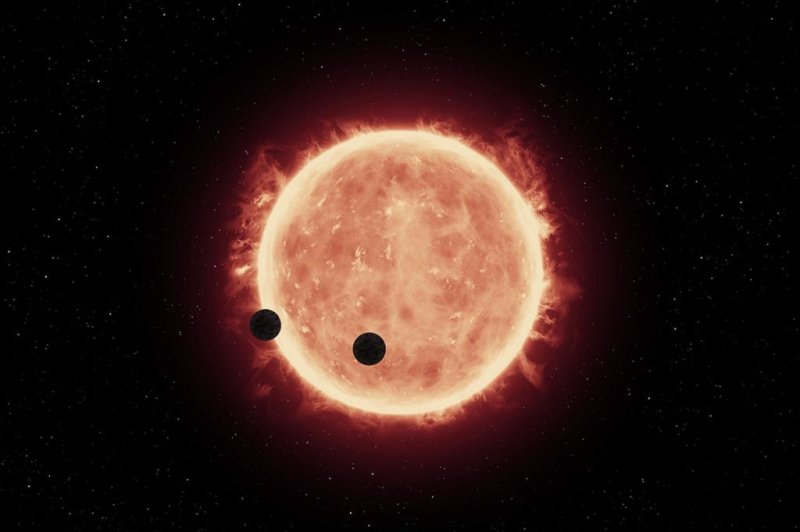An artistic rendering shows two Earth-sized exoplanets, TRAPPIST-1b and TRAPPIST-1c, traversing the face of their sun, a 500-million-year-old red dwarf star. Photo by NASA/ESA/STScI/J. de Wit/MIT
GREENBELT, Md., July 20 (UPI) -- New analysis suggests two Earth-like exoplanets are without large, hydrogen-rich atmospheres. The finding increases the chances of habitability on TRAPPIST-1b and TRAPPIST-1c.
Alien atmospheres heavy with hydrogen lend a greenhouse gas effect, rendering exoplanets much too hot to host life.
TRAPPIST-1b and TRAPPIST-1c are already hot enough, orbiting between 20 and 100 times closer to their host star than Earth is to the sun. Because their host star -- a 500-million-year-old red dwarf found 40 light-years away in the constellation of Aquarius -- is much fainter than the sun, researchers believe at least one of the exoplanets, TRAPPIST-1c, is within the star's habitable zone.
The research, detailed in the journal Nature, marks the first time astronomers have conducted an atmospheric survey of Earth-like exoplanets.
The survey was made possible by the exoplanets' biennial dual transit. In May, the two planets simultaneously crossed between the surface of the red dwarf and Earth, allowing Hubble to analyze the starlight as it passed across the outer edges of the two exoplanets.
For now, astronomers can only confirm that TRAPPIST-1b and TRAPPIST-1c are without dense atmospheres. In two years, when the exoplanets once again traverse the face of their sun, new, more powerful observational tools, like NASA's James Webb Space Telescope, may be able to offer a more detailed analysis.
"With more data, we could perhaps detect methane or see water features in the atmospheres, which would give us estimates of the depth of the atmospheres," Hannah Wakeford, a researcher at NASA's Goddard Space Flight Center, said in a news release.
"These Earth-sized planets are the first worlds that astronomers can study in detail with current and planned telescopes to determine whether they are suitable for life," added Julien de Wit, an astronomer at MIT. "Hubble has the facility to play the central atmospheric pre-screening role to tell astronomers which of these Earth-sized planets are prime candidates for more detailed study with the Webb telescope."















